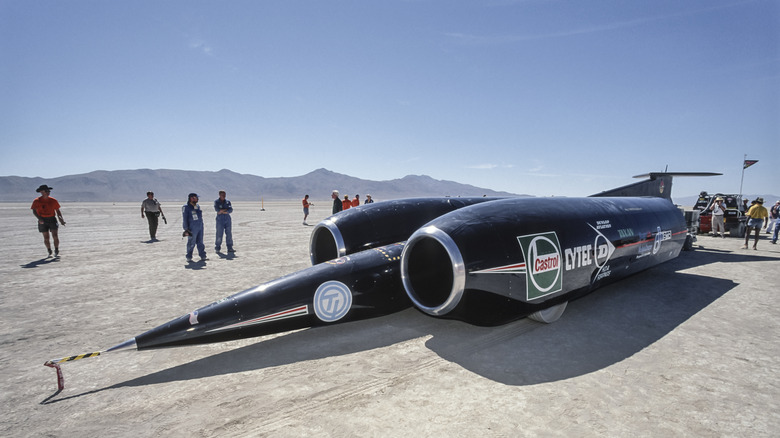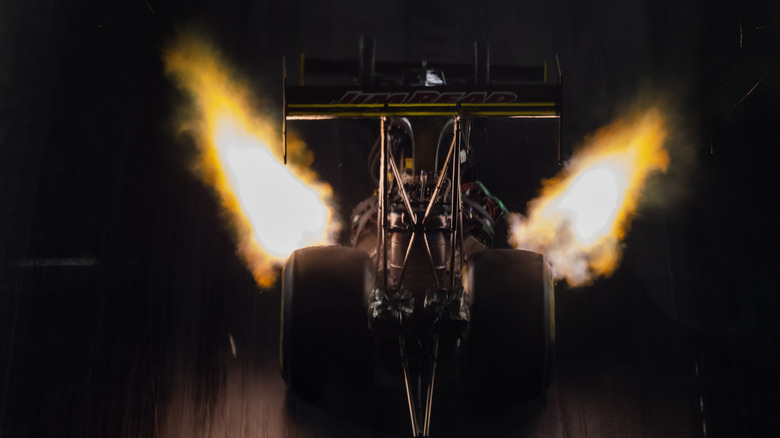Horsepower And Top Speed: How Closely Are The Two Related?
Generally speaking, we tend to associate high performance with high horsepower. After all, it's pretty much common sense that if two cars are identical in every detail, but one of them has more horsepower, that car will be faster in a straight line. However, absurdly high horsepower is only one factor contributing to a vehicle's top speed — in fact, dozens of variables all influence top speed in unique ways, some less obvious than others.
Take, for instance, a vehicle's gearing. Most cars are geared for efficiency or acceleration. A vehicle properly geared for top-speed will see its peak horsepower right at the very limit of its ability, so it's pushing the maximum amount of power when it needs that power most. Such a vehicle will naturally be faster than a car with the same horsepower, but unoptimized gears, since it won't reach the top of its power curve at the same point.
These factors apply to virtually every vehicle both on and off the road. For instance, four coupled Union Pacific Centennial diesel-electric locomotives produce more power than an N 700 Shinkansen bullet-train. But that freight setup couldn't hope to keep up with the Japanese engine, even unloaded, because it doesn't have the necessary streamlining. In many situations, aerodynamic drag is proportional to the square of the vehicle's speed. So faster speeds require exponentially less drag for the same horsepower, hence why streamlining is so important. Let's explore some more of these principles using other real-world examples.
What matters most in top speed
Let's jump right to vehicles judged on their top speed alone: land speed racing. A land speed record car features an extremely deliberate design, typically featuring a specialized streamliner body shaped like a raindrop, generating just enough downforce to keep it on the ground. Without that kind of body, the car wouldn't be able to go nearly as fast, because of the tremendous amount of air it has to push out of the way — streamlining allows a car to slice through the air rather than punch through it.
Air resistance is one of several factors when determining overall friction, with another significant example being friction with the road surface. A vehicle with a greater amount of area contacting the ground will be slower — it's why the fastest powerboat hulls skim above the surface of the water, rather than cutting through it. The benefits and deficits of wide versus narrow tires for top speed remains a topic of debate within the land speed community, though rolling resistance certainly plays a part in extracting a few extra miles an hour. That's why purpose-built tires typically feature lightweight designs with as little rolling resistance as possible.
All of this is to say, between two vehicles with equal horsepower, the more aerodynamic model with less drag and rolling resistance will go faster — that's just physics in action. Of course, horsepower still makes a world of difference, so let's explore how exactly it translates into the tires spinning faster.
The science of horsepower
It's no good to say that more horsepower equals more top speed without knowing how horsepower actually functions. Firstly, the is the equation to measure a car's horsepower: Horsepower = torque x RPM/5,252. Basically, horsepower increases with an engine's max RPM, tapering off at a certain point when the "5,252" number overcomes the torque figure. This produces a "power curve," which looks like a hill when plotted on a graph.
For the highest top speed, your car's RPM should be right at the top of that hill when it reaches its aerodynamic limit. This is because, while torque relates to how easily the wheels spin, horsepower dictates how quickly they can spin. So something with high torque and low horsepower, like a diesel truck, can pull more efficiently, but a car with higher horsepower than torque can spin its wheels faster and reach a higher speed.
That horsepower needs to move a certain amount of weight, but weight actually has a relatively minimal effect on how fast a car can go, at least compared to aerodynamic drag. This relates to Newton's first law: an object in motion tends to stay in motion, unless acted upon by an outside force. This means the air friction actively slowing the car down plays a bigger role. A car reaches its ultimate top speed when the force of the horsepower pushing it through the air equals the force of the air pushing back. Therefore, more horsepower and less drag equals more speed.


